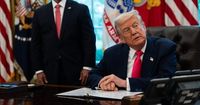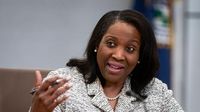In a week of high drama for American economic policy, Federal Reserve Chair Jerome Powell took the stage at the Jackson Hole Economic Policy Symposium on August 22, 2025, and delivered a speech that left the financial world buzzing. Powell, whose term as the nation’s top central banker ends in May 2026, signaled that the door is open for a potential interest rate cut as soon as September. Yet, his remarks came against a backdrop of intensifying political pressure from President Donald Trump, whose campaign to assert control over the Federal Reserve and other economic institutions is raising alarms across the financial and political spectrum.
Powell’s address was closely watched, not just for its economic implications but for what it revealed about the growing tension between the White House and the traditionally independent central bank. “Downside risks to employment are rising,” Powell warned, highlighting the precarious balance facing the U.S. economy. He pointed to both higher inflation—driven in part by tariffs whose effects are "now clearly visible"—and a weakening jobs market as key challenges. “While the labor market appears to be in balance, it is a curious kind of balance that results from a marked slowing in both the supply of and demand for workers,” he observed, hinting at the possibility of layoffs if conditions deteriorate further, according to reporting by AFP.
Powell also made clear that while the Fed is monitoring the effects of tariffs on consumer prices, the central bank would not allow a "one-time increase in the price level to become an ongoing inflation problem." Nevertheless, he left little doubt that monetary policy could soon shift: "With policy in restrictive territory, the baseline outlook and the shifting balance of risks may warrant adjusting our policy stance." For many analysts, this was as direct a signal as Powell could give that a rate cut is likely on the horizon. As Heather Long, chief economist at Navy Federal Credit Union, put it, “That’s about as clear cut as Powell can get in signaling that he leans towards a September rate cut.”
The financial markets responded with enthusiasm. Both the Dow and Nasdaq surged around 2% midday after Powell’s remarks, and the CME Group’s FedWatch Tool showed a 90% chance of a rate cut in September. Yet, as Ryan Sweet of Oxford Economics cautioned, this may not mark the beginning of a new era of easy money. "Powell stressed that policy isn't on a preset course and will continue to be based on the incoming data and the balance of risks," Sweet noted, suggesting the Fed is preparing for a gradual, data-driven approach.
But the story of U.S. economic policy this summer is about more than just interest rates. President Trump’s increasingly aggressive efforts to shape the Federal Reserve—and, by extension, the broader economic landscape—have put the independence of key institutions in the spotlight. On the same day as Powell’s speech, Trump publicly threatened to fire Federal Reserve Governor Lisa Cook if she did not resign. The threat followed accusations by Bill Pulte, director of the Federal Housing Finance Agency, that Cook had committed mortgage fraud involving properties in Michigan and Georgia. Cook, who submitted documents indicating a property in Atlanta as her personal residence after initially listing it for rent, has denied any wrongdoing. “I have no intention of being bullied,” she declared in a statement earlier this week, as reported by Axios.
Trump’s administration is reportedly building a criminal case against Cook, which, if successful, would create another vacancy on the powerful Fed Board of Governors. Trump already has two appointees on the seven-member board, with a third nomination pending before the Senate. Removing Cook could tip the balance in Trump’s favor, potentially giving him a majority and new leverage over the 12 regional Federal Reserve Bank presidents. The stakes are high: Ousting and replacing Cook could allow Trump to further reshape the central bank in his image, making it more likely to heed his calls for lower interest rates.
The president’s campaign to influence the Fed is not limited to personnel moves. As Bloomberg highlighted in a recent analysis, Trump has repeatedly criticized Powell for keeping rates steady and has even considered suing him over cost overruns at the Fed’s headquarters renovation. These actions, experts warn, represent a significant challenge to the principle of central bank independence—a cornerstone of economic policy in advanced economies. For decades, the Fed’s autonomy has insulated monetary policy from short-term political pressures, allowing it to focus on long-term economic stability.
Yet, Trump’s efforts to erode that independence are part of a broader pattern. As The New York Times reported, the administration has also fired the head of the Bureau of Labor Statistics after the agency reported weak job growth, used private tax data to pursue undocumented immigrants, and overridden independent grant decisions to cut funding for scientific and medical research. Each move carries its own risks, but taken together, they threaten to undermine the United States’ reputation as a safe, predictable place for investment and innovation.
“These are all real components of why people would trust the United States, and if you start taking them apart, you start eroding that trust,” explained Norbert Michel, an economist at the Cato Institute, to The New York Times. Daron Acemoglu, a Nobel Prize-winning economist at MIT, added, “Every part of the American success, such as it is—the U.S. as an innovation hub, the U.S. as a place where people bring their money for safety—those have all been rooted in some sort of belief and some sort of reality of U.S. courts and U.S. agencies functioning well.”
The independence of the Fed, accurate economic data, and consistent enforcement of rules have long underpinned America’s economic dominance. Investors have lent to the U.S. government at low rates, confident that the central bank would keep inflation in check and that economic data would remain trustworthy. “Good economic data is the bedrock of good policy,” said Donald Kohn, former Fed vice chair, in the same report.
Yet, the current environment has many economists worried that the U.S. could be heading down a path similar to countries like Argentina, Greece, and Turkey, where political interference in economic institutions has led to inflation, higher borrowing costs, and diminished investor confidence. Patrick Harker, former president of the Federal Reserve Bank of Philadelphia, cautioned, “When you breach the independence of a central bank, there’s no case where it turns out well in the long run. One has to be very careful messing with this.”
For now, the markets remain relatively calm, perhaps betting that the U.S. system’s institutional checks will hold. But as history shows, confidence can erode slowly—and then all at once. As Norbert Michel put it, “The most likely scenario is that you just start seeing things get chipped away, chipped away, and then eventually it just kind of blows up.”
With the Fed’s next meeting set for mid-September and political tensions running high, the world will be watching to see whether the U.S. can maintain the delicate balance that has long made its economy the envy of the world—or whether it’s about to tip into uncharted territory.

